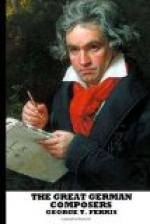The ideal background, from which the emotions of the human actors in the drama are reflected with supernatural light, is the conception of the “Holy Graal,” the mystic symbol of the Christian faith, and its descent from the skies, guarded by hosts of seraphim. This is the subject of the orchestral prelude, and never have the sweetnesses and terrors of the Christian ecstasy been more potently expressed. The prelude opens with long-drawn chords of the violins, in the highest octaves, in the most exquisite pianissimo. The inner eye of the spirit discerns in this the suggestion of shapeless white clouds, hardly discernible from the aerial blue of the sky. Suddenly the strings seem to sound from the farthest distance, in continued pianissimo, and the melody, the Graal-motive, takes shape. Gradually, to the fancy, a group of angels seem to reveal themselves, slowly descending from the heavenly heights, and bearing in their midst the Sangreal. The modulations throb through the air, augmenting in richness and sweetness, till the fortissimo of the full orchestra reveals the sacred mystery. With this climax of spiritual ecstasy the harmonious waves gradually recede and ebb away in dying sweetness, as the angels return to their heavenly abode. This orchestral movement recurs in the opera, according to the laws of dramatic fitness, and its melody is heard also in the logos of Lohengrin, the knight of the Graal, to express certain phases of his action. The immense power which music is thus made to have in dramatic effect can easily be fancied.
A fourth prominent characteristic of the Wagner music-drama is that, to develop its full splendor, there must be a cooperation of all the arts, painting, sculpture, and architecture, as well as poetry and music. Therefore, in realizing its effects, much importance rests in the visible beauties of action, as they may be expressed by the painting of scenery and the grouping of human figures. Well may such a grand conception be called the “Art-work of the Future.”
Wagner for a long time despaired of the visible execution of his ideas. At last the celebrated pianist Tausig suggested an appeal to the admirers of the new music throughout the world for means to carry out the composer’s great idea, viz., to perform the “Nibelungen” at a theatre to be erected for the purpose, and by a select company, in the manner of a national festival, and before an




